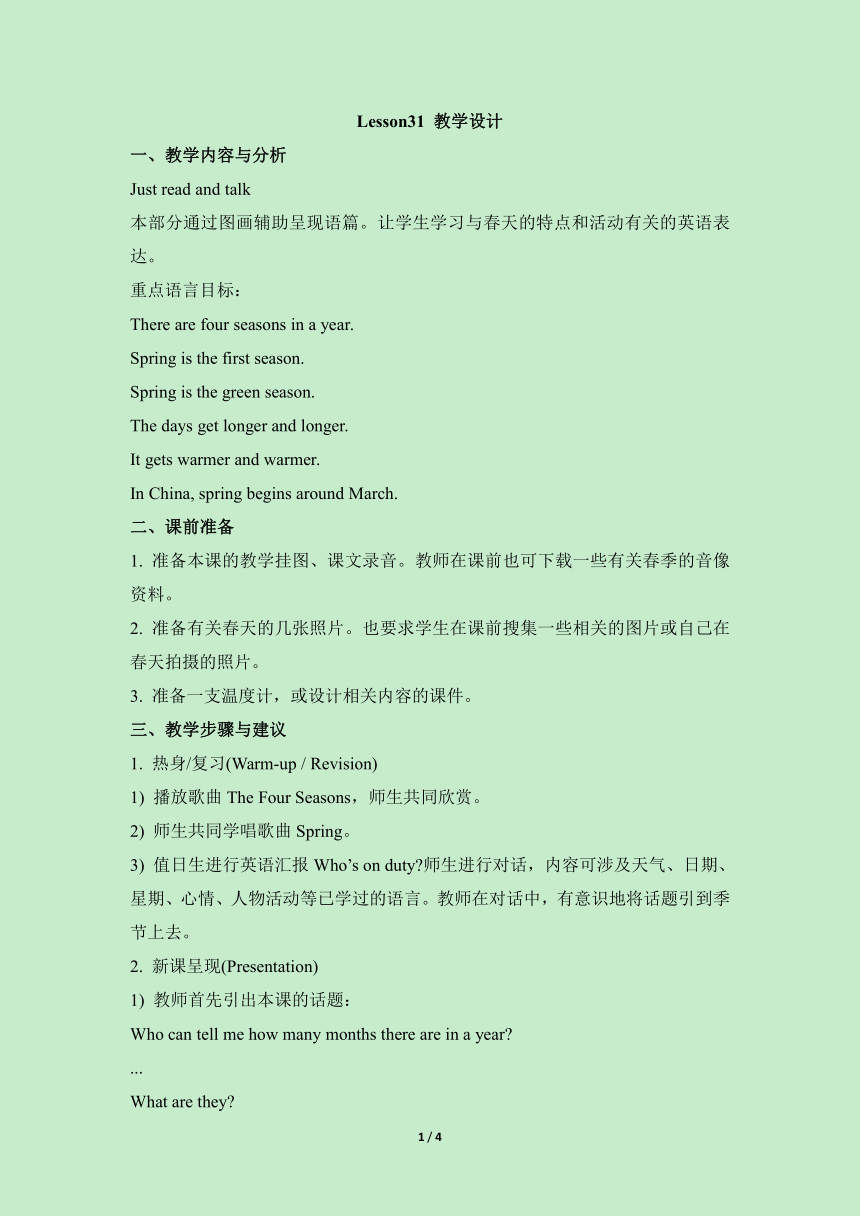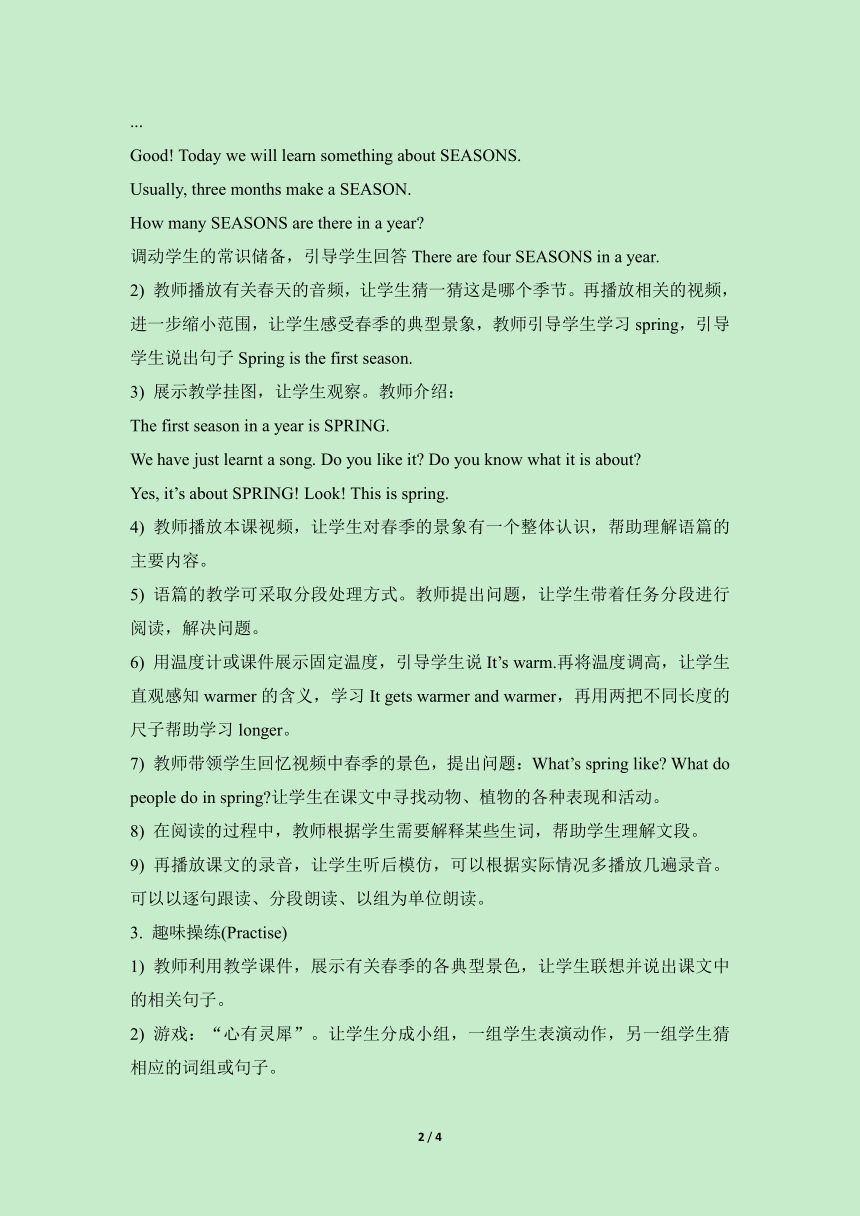Unit 6 There are four seasons in a year Lesson 31 教学设计
文档属性
| 名称 | Unit 6 There are four seasons in a year Lesson 31 教学设计 |  | |
| 格式 | zip | ||
| 文件大小 | 8.8KB | ||
| 资源类型 | 教案 | ||
| 版本资源 | 人教精通版(三年级起点) | ||
| 科目 | 英语 | ||
| 更新时间 | 2018-06-14 18:51:56 | ||
图片预览


文档简介
Lesson31 教学设计
一、教学内容与分析
Just read and talk
本部分通过图画辅助呈现语篇。让学生学习与春天的特点和活动有关的英语表达。
重点语言目标:
There are four seasons in a year.
Spring is the first season.
Spring is the green season.
The days get longer and longer.
It gets warmer and warmer.
In China, spring begins around March.
二、课前准备
1. 准备本课的教学挂图、课文录音。教师在课前也可下载一些有关春季的音像资料。
2. 准备有关春天的几张照片。也要求学生在课前搜集一些相关的图片或自己在春天拍摄的照片。
3. 准备一支温度计,或设计相关内容的课件。
三、教学步骤与建议
1. 热身/复习(Warm-up / Revision)
1) 播放歌曲The Four Seasons,师生共同欣赏。
2) 师生共同学唱歌曲Spring。
3) 值日生进行英语汇报Who’s on duty?师生进行对话,内容可涉及天气、日期、星期、心情、人物活动等已学过的语言。教师在对话中,有意识地将话题引到季节上去。
2. 新课呈现(Presentation)
1) 教师首先引出本课的话题:
Who can tell me how many months there are in a year?
...
What are they?
...
Good! Today we will learn something about SEASONS.
Usually, three months make a SEASON.
How many SEASONS are there in a year?
调动学生的常识储备,引导学生回答There are four SEASONS in a year.
2) 教师播放有关春天的音频,让学生猜一猜这是哪个季节。再播放相关的视频,进一步缩小范围,让学生感受春季的典型景象,教师引导学生学习spring,引导学生说出句子Spring is the first season.
3) 展示教学挂图,让学生观察。教师介绍:
The first season in a year is SPRING.
We have just learnt a song. Do you like it? Do you know what it is about?
Yes, it’s about SPRING! Look! This is spring.
4) 教师播放本课视频,让学生对春季的景象有一个整体认识,帮助理解语篇的主要内容。
5) 语篇的教学可采取分段处理方式。教师提出问题,让学生带着任务分段进行阅读,解决问题。
6) 用温度计或课件展示固定温度,引导学生说It’s warm.再将温度调高,让学生直观感知warmer的含义,学习It gets warmer and warmer,再用两把不同长度的尺子帮助学习longer。
7) 教师带领学生回忆视频中春季的景色,提出问题:What’s spring like? What do people do in spring?让学生在课文中寻找动物、植物的各种表现和活动。
8) 在阅读的过程中,教师根据学生需要解释某些生词,帮助学生理解文段。
9) 再播放课文的录音,让学生听后模仿,可以根据实际情况多播放几遍录音。可以以逐句跟读、分段朗读、以组为单位朗读。
3. 趣味操练(Practise)
1) 教师利用教学课件,展示有关春季的各典型景色,让学生联想并说出课文中的相关句子。
2) 游戏:“心有灵犀”。让学生分成小组,一组学生表演动作,另一组学生猜相应的词组或句子。
可操练的语句:
What do they do?
Farmers farm the land.
People go on outings.
They fly kites.
3) 游戏:“听命令排队”。教师分发教学卡片,让拿到卡片的学生到教室前面,按照教师所念语句的先后按顺序站队。可多练几组,让学生不仅能记住自己卡片的内容,也了解前后同学的卡片内容。
4) 利用教室内随处可见的资源对比较级进行初步的操练。如:教师展示一把尺子,说:It is long. Whose ruler is longer? 让学生展示更长的尺子,说:It is longer.
4. 语言运用(Language use)
情景设置1:教师可将课文内容设计为填空游戏,提供首字母提示,让学生补全短文并复述。
语言支持:
There are four s_______ in a year. S_______ is the f_______ season. In C_______ , springtime b_______ around M_______ . It is still a little c_______ , but it g_______ w_______ and w_______ , and the d_______ get 1_______ and 1_______.
情景设置2:让学生分成5人小组,自由联想有关spring的事物。包括学过的英语单词、汉语词语、气候知识、孩子们自己过去的有关春天的经历等。各小组把联想内容用适当形式记录下来,有机会的时候与大家分享。
5. 课堂评价(Assessment)
1) 教师应当运用多种形式进行课堂评价,包括对学生掌握本课基本知识情况的评价和对学生综合能力的评价。
评价项目
1
2
3
4
5
学生喜欢本课内容的程度
学生参与课堂活动的积极性
学生小组合作的能力
学生在各游戏环节的表现
总体表现
分数
2) 引导学生对自己在课堂上的表现进行自我评价。
评价项目
1
2
3
4
5
我对老师说的英语和录音内容的理解
我能听懂、会说有关季节和春天话题的简单英语
我在联想活动中想出很多内容
我能积极思考,主动表达自己的观点
我在阅读、表演时声音响亮,表情自然
总体表现
分数
6. 拓展活动(Extended activities)
1) 用学过的句子和单词作替换练习,结合实际情况说出更多的句子,比一比谁能说出的句子多。下面的内容教师可根据情况选用,也可补充更多的内容。
There are four seasons in a year.
There are sixty minutes in an hour.
There are twenty-four hours in a day.
There are seven days in a week.
There are four weeks in a month.
There are thirty or thirty-one days in a month.
There are twelve months in a year.
There are 365 days in a year.
2) 听力练习,根据录音填入所缺的单词:
There are _______ seasons in a year. _______ is the first season. In _______ springtime begins around February. The weather is still a little _______, but it gets warmer and _______, and the days get longer and _______. Spring is the _______ season. The _______ have new green leaves. There _______ lots of new flowers _______ the cherry trees, apple trees and peach trees. The animals _______ up from their long sleep. _______ sing to the spring. Farmers are _______. They _______ the land. People go _______ outings. Children _______ kites. Everyone _______ the spring.
一、教学内容与分析
Just read and talk
本部分通过图画辅助呈现语篇。让学生学习与春天的特点和活动有关的英语表达。
重点语言目标:
There are four seasons in a year.
Spring is the first season.
Spring is the green season.
The days get longer and longer.
It gets warmer and warmer.
In China, spring begins around March.
二、课前准备
1. 准备本课的教学挂图、课文录音。教师在课前也可下载一些有关春季的音像资料。
2. 准备有关春天的几张照片。也要求学生在课前搜集一些相关的图片或自己在春天拍摄的照片。
3. 准备一支温度计,或设计相关内容的课件。
三、教学步骤与建议
1. 热身/复习(Warm-up / Revision)
1) 播放歌曲The Four Seasons,师生共同欣赏。
2) 师生共同学唱歌曲Spring。
3) 值日生进行英语汇报Who’s on duty?师生进行对话,内容可涉及天气、日期、星期、心情、人物活动等已学过的语言。教师在对话中,有意识地将话题引到季节上去。
2. 新课呈现(Presentation)
1) 教师首先引出本课的话题:
Who can tell me how many months there are in a year?
...
What are they?
...
Good! Today we will learn something about SEASONS.
Usually, three months make a SEASON.
How many SEASONS are there in a year?
调动学生的常识储备,引导学生回答There are four SEASONS in a year.
2) 教师播放有关春天的音频,让学生猜一猜这是哪个季节。再播放相关的视频,进一步缩小范围,让学生感受春季的典型景象,教师引导学生学习spring,引导学生说出句子Spring is the first season.
3) 展示教学挂图,让学生观察。教师介绍:
The first season in a year is SPRING.
We have just learnt a song. Do you like it? Do you know what it is about?
Yes, it’s about SPRING! Look! This is spring.
4) 教师播放本课视频,让学生对春季的景象有一个整体认识,帮助理解语篇的主要内容。
5) 语篇的教学可采取分段处理方式。教师提出问题,让学生带着任务分段进行阅读,解决问题。
6) 用温度计或课件展示固定温度,引导学生说It’s warm.再将温度调高,让学生直观感知warmer的含义,学习It gets warmer and warmer,再用两把不同长度的尺子帮助学习longer。
7) 教师带领学生回忆视频中春季的景色,提出问题:What’s spring like? What do people do in spring?让学生在课文中寻找动物、植物的各种表现和活动。
8) 在阅读的过程中,教师根据学生需要解释某些生词,帮助学生理解文段。
9) 再播放课文的录音,让学生听后模仿,可以根据实际情况多播放几遍录音。可以以逐句跟读、分段朗读、以组为单位朗读。
3. 趣味操练(Practise)
1) 教师利用教学课件,展示有关春季的各典型景色,让学生联想并说出课文中的相关句子。
2) 游戏:“心有灵犀”。让学生分成小组,一组学生表演动作,另一组学生猜相应的词组或句子。
可操练的语句:
What do they do?
Farmers farm the land.
People go on outings.
They fly kites.
3) 游戏:“听命令排队”。教师分发教学卡片,让拿到卡片的学生到教室前面,按照教师所念语句的先后按顺序站队。可多练几组,让学生不仅能记住自己卡片的内容,也了解前后同学的卡片内容。
4) 利用教室内随处可见的资源对比较级进行初步的操练。如:教师展示一把尺子,说:It is long. Whose ruler is longer? 让学生展示更长的尺子,说:It is longer.
4. 语言运用(Language use)
情景设置1:教师可将课文内容设计为填空游戏,提供首字母提示,让学生补全短文并复述。
语言支持:
There are four s_______ in a year. S_______ is the f_______ season. In C_______ , springtime b_______ around M_______ . It is still a little c_______ , but it g_______ w_______ and w_______ , and the d_______ get 1_______ and 1_______.
情景设置2:让学生分成5人小组,自由联想有关spring的事物。包括学过的英语单词、汉语词语、气候知识、孩子们自己过去的有关春天的经历等。各小组把联想内容用适当形式记录下来,有机会的时候与大家分享。
5. 课堂评价(Assessment)
1) 教师应当运用多种形式进行课堂评价,包括对学生掌握本课基本知识情况的评价和对学生综合能力的评价。
评价项目
1
2
3
4
5
学生喜欢本课内容的程度
学生参与课堂活动的积极性
学生小组合作的能力
学生在各游戏环节的表现
总体表现
分数
2) 引导学生对自己在课堂上的表现进行自我评价。
评价项目
1
2
3
4
5
我对老师说的英语和录音内容的理解
我能听懂、会说有关季节和春天话题的简单英语
我在联想活动中想出很多内容
我能积极思考,主动表达自己的观点
我在阅读、表演时声音响亮,表情自然
总体表现
分数
6. 拓展活动(Extended activities)
1) 用学过的句子和单词作替换练习,结合实际情况说出更多的句子,比一比谁能说出的句子多。下面的内容教师可根据情况选用,也可补充更多的内容。
There are four seasons in a year.
There are sixty minutes in an hour.
There are twenty-four hours in a day.
There are seven days in a week.
There are four weeks in a month.
There are thirty or thirty-one days in a month.
There are twelve months in a year.
There are 365 days in a year.
2) 听力练习,根据录音填入所缺的单词:
There are _______ seasons in a year. _______ is the first season. In _______ springtime begins around February. The weather is still a little _______, but it gets warmer and _______, and the days get longer and _______. Spring is the _______ season. The _______ have new green leaves. There _______ lots of new flowers _______ the cherry trees, apple trees and peach trees. The animals _______ up from their long sleep. _______ sing to the spring. Farmers are _______. They _______ the land. People go _______ outings. Children _______ kites. Everyone _______ the spring.
同课章节目录
- Unit 1 I go to school at 8:00.
- Lesson 1
- Lesson 2
- Lesson 3
- Lesson 4
- Lesson 5
- Lesson 6
- Unit 2 What's your hobby?
- Lesson 7
- Lesson 8
- Lesson 9
- Lesson 10
- Lesson 11
- Lesson 12
- Unit 3 Would you like to come to my birthday party
- Lesson 13
- Lesson 14
- Lesson 15
- Lesson 16
- Lesson 17
- Lesson 18
- Fun Time 1
- Recycle 1
- Recycle 2
- Fun Reading
- Unit 4 January is the first month.
- Lesson 19
- Lesson 20
- Lesson 21
- Lesson 22
- Lesson 23
- Lesson 24
- Unit 5 July is the seventh month.
- Lesson 25
- Lesson 26
- Lesson 27
- Lesson 28
- Lesson 29
- Lesson 30
- Unit 6 There are four seasons in a year.
- Lesson 31
- Lesson 32
- Lesson 33
- Lesson 34
- Lesson 35
- Lesson 36
- Fun Time 2
- Recycle 1
- Recycle 2
- Fun Reading
